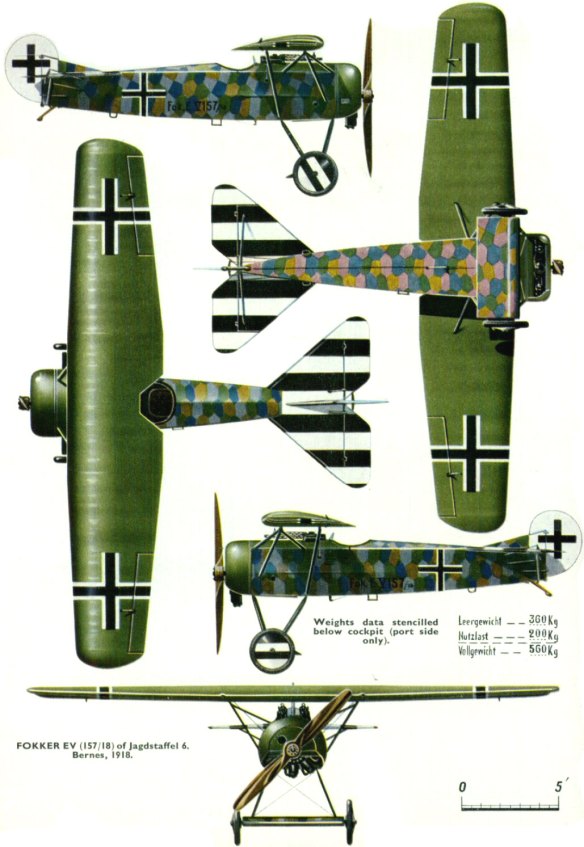Too little, too late? The `Flying Razor’ might well have made a difference if it had entered service earlier and in greater numbers.
Modern-day military combat aircraft often have a long service life. In some cases, 40 years or more. Examples are the Boeing B-52 and English Electric Canberra, where individual aircraft have been older than the crews that have flown them.
Back in 1914-18, the active in-service lifetime of WW1 combat aircraft could often be measured in months only, before obsolescence set in as military hierarchy, aircraft designers and manufacturers on both sides of the conflict strove to achieve or maintain superiority of combat performance over the aircraft of the enemy. Lives depended upon it!
On the German side, the latest in a succession of competitions for the supply of fighters, in early 1918, led to the selection of the Fokker D. VII, the best of a number of machines, all of which were required to use the 160/180 hp Mercedes engine.
The D. VII went into immediate production, but the German High Command were fully aware of how quickly the performance of a new aircraft could be eclipsed and immediately decided to float a further fighter design competition, the requirements of which were circularised among the manufacturers, including Albatros, Dornier, Kondor, LVG, Pfalz, Roland, Rumpler, Seimens-Schuckert and Fokker.
At the latter company, Designer Reinhold Platz had in hand a number of experimental parasol monoplane configuration designs, V26. V27 and V28.
When this new competition was run off, it was leading pilots from the Jagdstaffeln in the war zones who did the comparative testing and who were the arbiters of which design would be selected as the follow-on fighter. Their shortlist whittled down the choice to the Dornier D1, Seimens Schuckert and Fokker V26/V28. Finally, the Fokker design was selected, receiving the official designation E. V (`E’ for eindecker).
The production order required 400 machines, the first 20 being delivered in July 1918. Jagdstaffel 6 was the first unit to get their hands on the new fighter, receiving six in early August, but before the end of the month, three of their pilots had been killed due to wing failures.
Urgent official investigations blamed these failures on deformation under heavy in-flight wing loads, but further more practical examination revealed poor standard of construction, which included the use of unseasoned wood and perished glue. Immediate improvement in quality control and adherence to the designer’s original construction specifications quickly cured these ills.
Re-designated Fokker D. VIII, the aircraft re-entered service. Jagdstaffel 11 were the first to re-equip, followed by Jagdstafeln 1, 6, 10, 19, 23, 36 and the Marine-Feld-Jagdstaffeln 1, 2 and 3.
However, the D. VIII saw only three weeks of combat service before the November 11th armistice, during which the aircraft proved to be an effective fighting machine. More powerful variants using the 145 hp Uberursel UR III rotary engine and 200 hp Goebel Goe IIIa were planned and had these entered service, they could well have given the newly formed Royal Air Force’s squadrons equipped with S. E. 5as and Sopwith Snipes a hard time indeed.
As also occurred in 1945, there was a post WW1 round-up of German aircraft by the Allies, including some of the 85 examples of the Fokker D. VIII operational with German Air Service units. Some of these were shared among the Allies for evaluation including US Air Service.
But not before Anthony Fokker had spirited 20 examples away to his native Holland, from where he sold some to the Netherlands Air Service. Others were sold to Poland, to equip the 7th Aviation Squadron and used during 1919, in that country’s conflict with Ukraine.
In 1921 Lieutenant Leigh Wade of the US Air Service produced the following evaluation of the D. VIII after testing at McCook Field:-
`The aeroplane has a tendency to turn to the right in taxiing, takes off quickly, climbs very rapidly and is very manoeuvrable.
It is easy to fly and the controls are sensitive. It is tail heavy, but so light on the controls that it is not tiresome to fly. The visibility is good.
The machine’s guns are so placed that in the event of a crash, the pilot would undoubtedly be injured by being thrown against same.
The aeroplane lands very slowly with a slight tendency to drop the right wing and to turn to the right on the ground. The controls for the engine are very inconveniently located, in as much as the throttle for the gas is in the left side of the fuselage and the throttle for the air is on the left side of the control stick.’
Such then was the Fokker D. VIII, a fighter aircraft of great promise, that just ran out of time … rather like that other great German fighter, a generation later – the Messerschmitt Me262!
